Japanese Linguistic Politeness
VerifiedAdded on 2023/06/12
|13
|3611
|282
AI Summary
This article discusses the determinants of linguistic politeness in Japanese, including face wants, societal position, and relationships of participants, social norms, and the immediate context of interaction. It also explores how social differences such as gender and seniority level manifest themselves in polite speech.
Contribute Materials
Your contribution can guide someone’s learning journey. Share your
documents today.

Japanese Linguistic Politeness
Name
Course
Word Count:
Name
Course
Word Count:
Secure Best Marks with AI Grader
Need help grading? Try our AI Grader for instant feedback on your assignments.
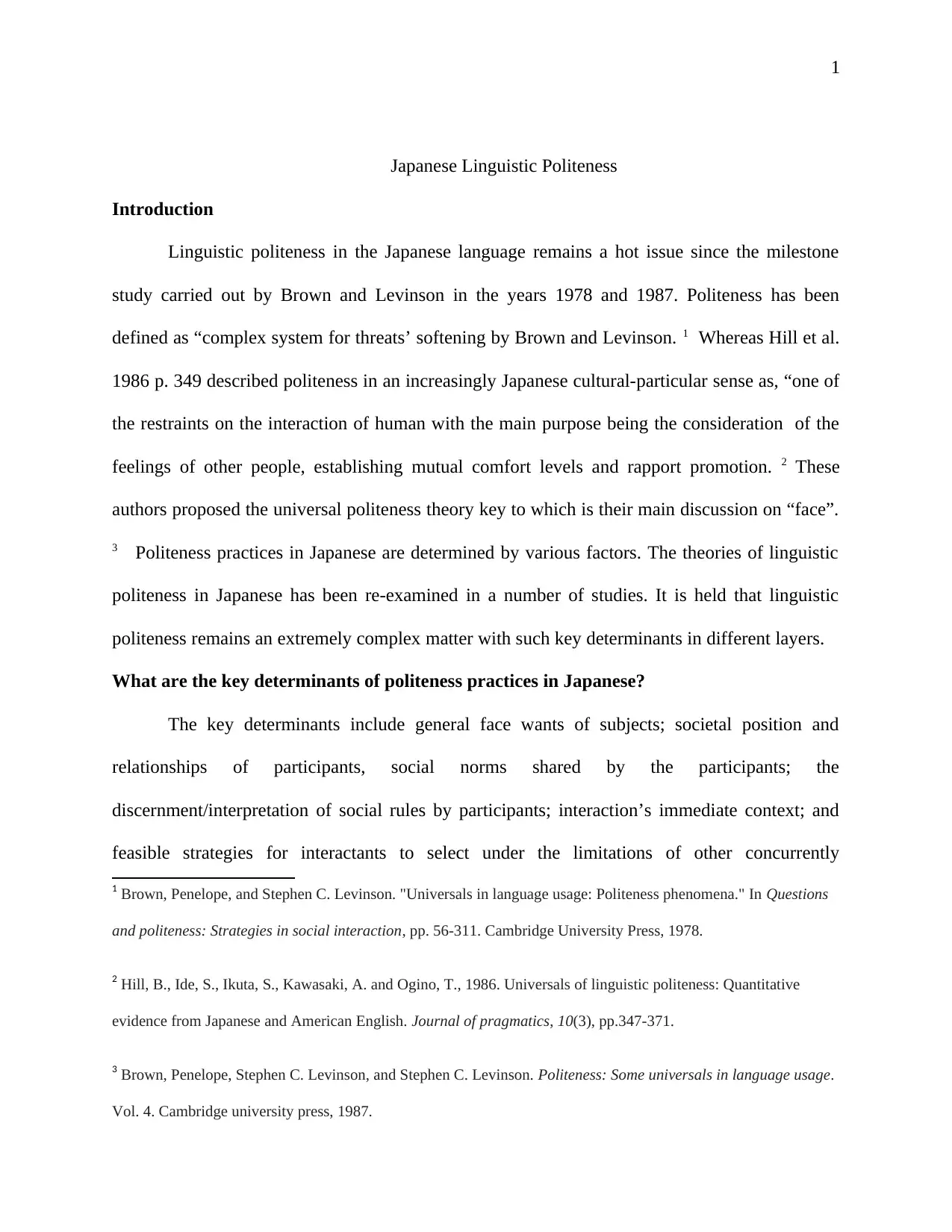
1
Japanese Linguistic Politeness
Introduction
Linguistic politeness in the Japanese language remains a hot issue since the milestone
study carried out by Brown and Levinson in the years 1978 and 1987. Politeness has been
defined as “complex system for threats’ softening by Brown and Levinson. 1 Whereas Hill et al.
1986 p. 349 described politeness in an increasingly Japanese cultural-particular sense as, “one of
the restraints on the interaction of human with the main purpose being the consideration of the
feelings of other people, establishing mutual comfort levels and rapport promotion. 2 These
authors proposed the universal politeness theory key to which is their main discussion on “face”.
3 Politeness practices in Japanese are determined by various factors. The theories of linguistic
politeness in Japanese has been re-examined in a number of studies. It is held that linguistic
politeness remains an extremely complex matter with such key determinants in different layers.
What are the key determinants of politeness practices in Japanese?
The key determinants include general face wants of subjects; societal position and
relationships of participants, social norms shared by the participants; the
discernment/interpretation of social rules by participants; interaction’s immediate context; and
feasible strategies for interactants to select under the limitations of other concurrently
1 Brown, Penelope, and Stephen C. Levinson. "Universals in language usage: Politeness phenomena." In Questions
and politeness: Strategies in social interaction, pp. 56-311. Cambridge University Press, 1978.
2 Hill, B., Ide, S., Ikuta, S., Kawasaki, A. and Ogino, T., 1986. Universals of linguistic politeness: Quantitative
evidence from Japanese and American English. Journal of pragmatics, 10(3), pp.347-371.
3 Brown, Penelope, Stephen C. Levinson, and Stephen C. Levinson. Politeness: Some universals in language usage.
Vol. 4. Cambridge university press, 1987.
Japanese Linguistic Politeness
Introduction
Linguistic politeness in the Japanese language remains a hot issue since the milestone
study carried out by Brown and Levinson in the years 1978 and 1987. Politeness has been
defined as “complex system for threats’ softening by Brown and Levinson. 1 Whereas Hill et al.
1986 p. 349 described politeness in an increasingly Japanese cultural-particular sense as, “one of
the restraints on the interaction of human with the main purpose being the consideration of the
feelings of other people, establishing mutual comfort levels and rapport promotion. 2 These
authors proposed the universal politeness theory key to which is their main discussion on “face”.
3 Politeness practices in Japanese are determined by various factors. The theories of linguistic
politeness in Japanese has been re-examined in a number of studies. It is held that linguistic
politeness remains an extremely complex matter with such key determinants in different layers.
What are the key determinants of politeness practices in Japanese?
The key determinants include general face wants of subjects; societal position and
relationships of participants, social norms shared by the participants; the
discernment/interpretation of social rules by participants; interaction’s immediate context; and
feasible strategies for interactants to select under the limitations of other concurrently
1 Brown, Penelope, and Stephen C. Levinson. "Universals in language usage: Politeness phenomena." In Questions
and politeness: Strategies in social interaction, pp. 56-311. Cambridge University Press, 1978.
2 Hill, B., Ide, S., Ikuta, S., Kawasaki, A. and Ogino, T., 1986. Universals of linguistic politeness: Quantitative
evidence from Japanese and American English. Journal of pragmatics, 10(3), pp.347-371.
3 Brown, Penelope, Stephen C. Levinson, and Stephen C. Levinson. Politeness: Some universals in language usage.
Vol. 4. Cambridge university press, 1987.
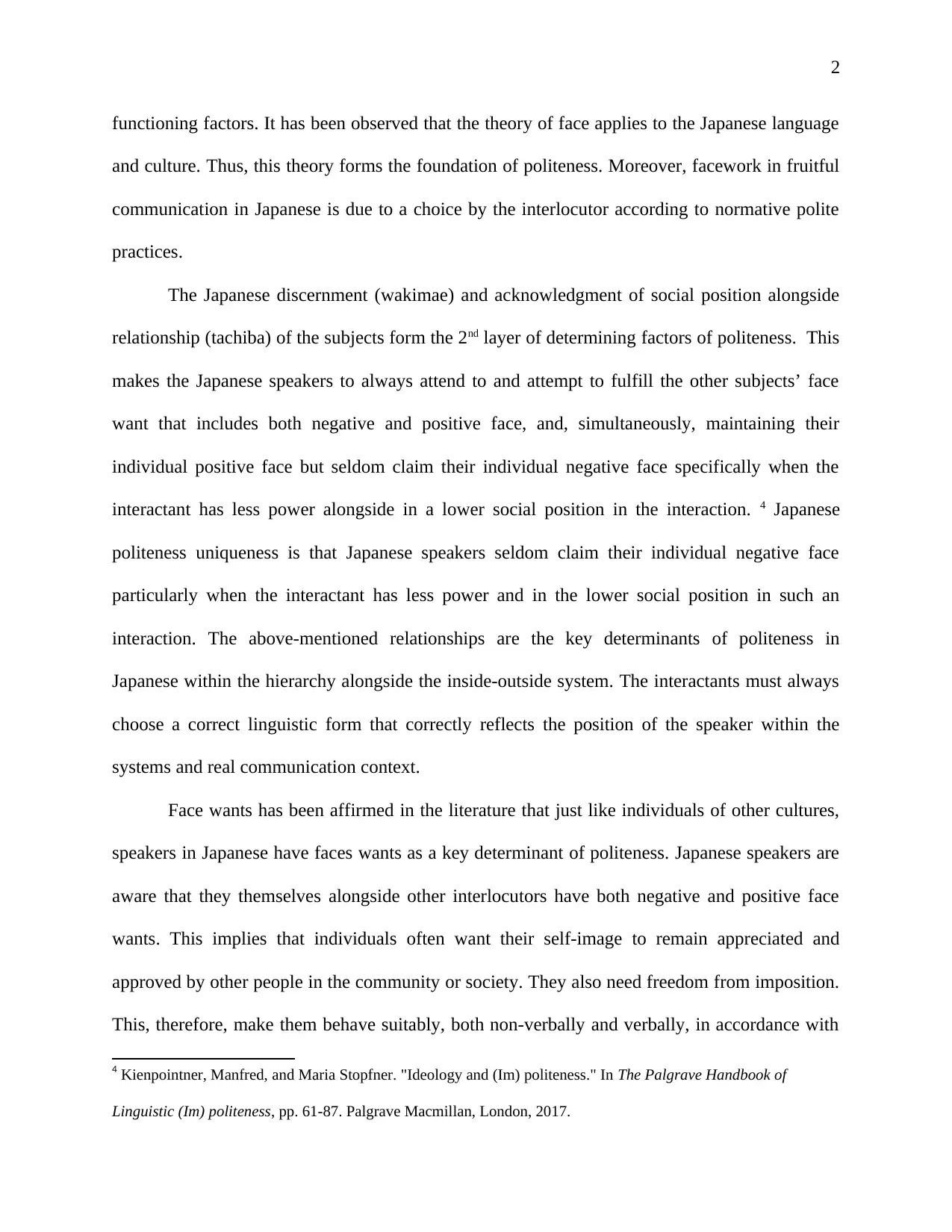
2
functioning factors. It has been observed that the theory of face applies to the Japanese language
and culture. Thus, this theory forms the foundation of politeness. Moreover, facework in fruitful
communication in Japanese is due to a choice by the interlocutor according to normative polite
practices.
The Japanese discernment (wakimae) and acknowledgment of social position alongside
relationship (tachiba) of the subjects form the 2nd layer of determining factors of politeness. This
makes the Japanese speakers to always attend to and attempt to fulfill the other subjects’ face
want that includes both negative and positive face, and, simultaneously, maintaining their
individual positive face but seldom claim their individual negative face specifically when the
interactant has less power alongside in a lower social position in the interaction. 4 Japanese
politeness uniqueness is that Japanese speakers seldom claim their individual negative face
particularly when the interactant has less power and in the lower social position in such an
interaction. The above-mentioned relationships are the key determinants of politeness in
Japanese within the hierarchy alongside the inside-outside system. The interactants must always
choose a correct linguistic form that correctly reflects the position of the speaker within the
systems and real communication context.
Face wants has been affirmed in the literature that just like individuals of other cultures,
speakers in Japanese have faces wants as a key determinant of politeness. Japanese speakers are
aware that they themselves alongside other interlocutors have both negative and positive face
wants. This implies that individuals often want their self-image to remain appreciated and
approved by other people in the community or society. They also need freedom from imposition.
This, therefore, make them behave suitably, both non-verbally and verbally, in accordance with
4 Kienpointner, Manfred, and Maria Stopfner. "Ideology and (Im) politeness." In The Palgrave Handbook of
Linguistic (Im) politeness, pp. 61-87. Palgrave Macmillan, London, 2017.
functioning factors. It has been observed that the theory of face applies to the Japanese language
and culture. Thus, this theory forms the foundation of politeness. Moreover, facework in fruitful
communication in Japanese is due to a choice by the interlocutor according to normative polite
practices.
The Japanese discernment (wakimae) and acknowledgment of social position alongside
relationship (tachiba) of the subjects form the 2nd layer of determining factors of politeness. This
makes the Japanese speakers to always attend to and attempt to fulfill the other subjects’ face
want that includes both negative and positive face, and, simultaneously, maintaining their
individual positive face but seldom claim their individual negative face specifically when the
interactant has less power alongside in a lower social position in the interaction. 4 Japanese
politeness uniqueness is that Japanese speakers seldom claim their individual negative face
particularly when the interactant has less power and in the lower social position in such an
interaction. The above-mentioned relationships are the key determinants of politeness in
Japanese within the hierarchy alongside the inside-outside system. The interactants must always
choose a correct linguistic form that correctly reflects the position of the speaker within the
systems and real communication context.
Face wants has been affirmed in the literature that just like individuals of other cultures,
speakers in Japanese have faces wants as a key determinant of politeness. Japanese speakers are
aware that they themselves alongside other interlocutors have both negative and positive face
wants. This implies that individuals often want their self-image to remain appreciated and
approved by other people in the community or society. They also need freedom from imposition.
This, therefore, make them behave suitably, both non-verbally and verbally, in accordance with
4 Kienpointner, Manfred, and Maria Stopfner. "Ideology and (Im) politeness." In The Palgrave Handbook of
Linguistic (Im) politeness, pp. 61-87. Palgrave Macmillan, London, 2017.
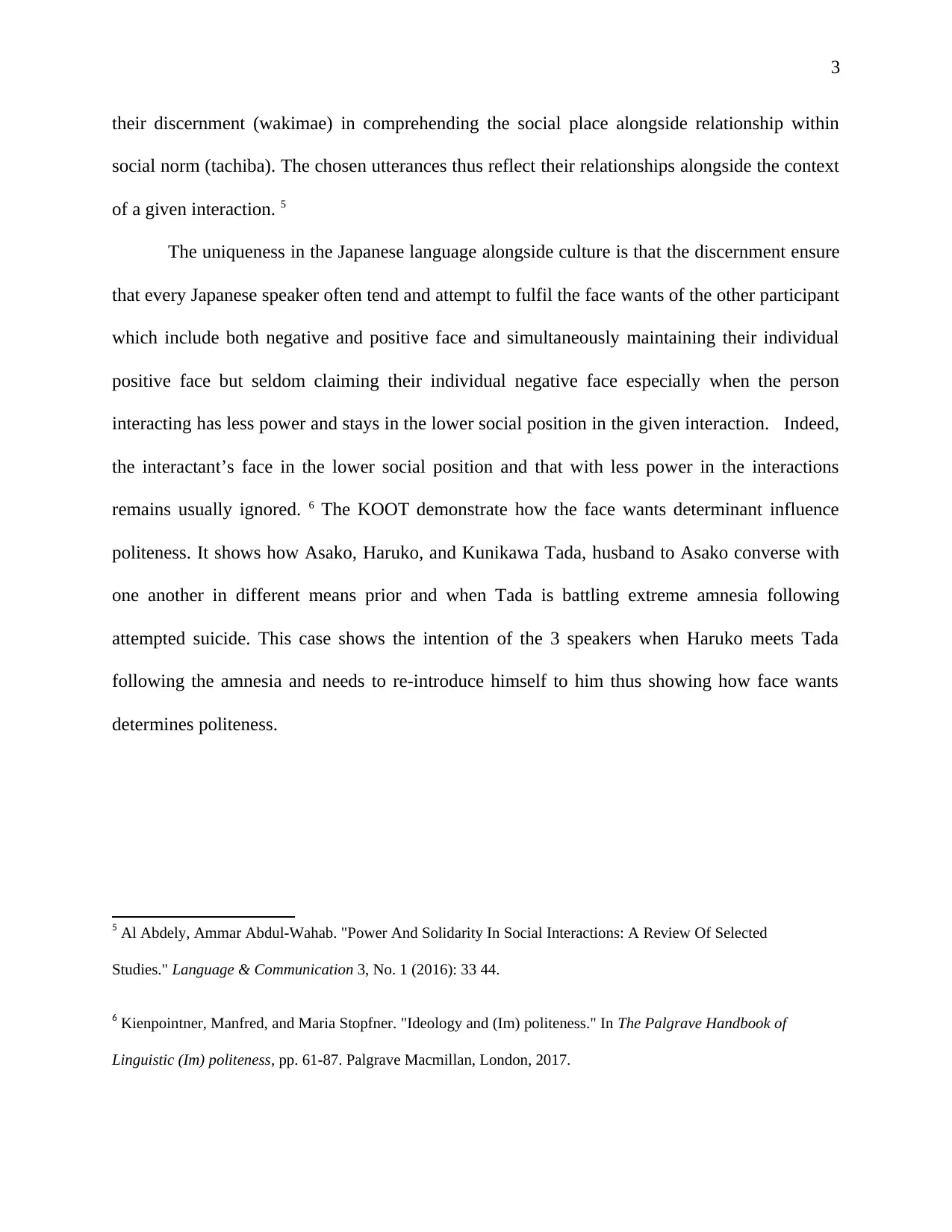
3
their discernment (wakimae) in comprehending the social place alongside relationship within
social norm (tachiba). The chosen utterances thus reflect their relationships alongside the context
of a given interaction. 5
The uniqueness in the Japanese language alongside culture is that the discernment ensure
that every Japanese speaker often tend and attempt to fulfil the face wants of the other participant
which include both negative and positive face and simultaneously maintaining their individual
positive face but seldom claiming their individual negative face especially when the person
interacting has less power and stays in the lower social position in the given interaction. Indeed,
the interactant’s face in the lower social position and that with less power in the interactions
remains usually ignored. 6 The KOOT demonstrate how the face wants determinant influence
politeness. It shows how Asako, Haruko, and Kunikawa Tada, husband to Asako converse with
one another in different means prior and when Tada is battling extreme amnesia following
attempted suicide. This case shows the intention of the 3 speakers when Haruko meets Tada
following the amnesia and needs to re-introduce himself to him thus showing how face wants
determines politeness.
5 Al Abdely, Ammar Abdul-Wahab. "Power And Solidarity In Social Interactions: A Review Of Selected
Studies." Language & Communication 3, No. 1 (2016): 33 44.
6 Kienpointner, Manfred, and Maria Stopfner. "Ideology and (Im) politeness." In The Palgrave Handbook of
Linguistic (Im) politeness, pp. 61-87. Palgrave Macmillan, London, 2017.
their discernment (wakimae) in comprehending the social place alongside relationship within
social norm (tachiba). The chosen utterances thus reflect their relationships alongside the context
of a given interaction. 5
The uniqueness in the Japanese language alongside culture is that the discernment ensure
that every Japanese speaker often tend and attempt to fulfil the face wants of the other participant
which include both negative and positive face and simultaneously maintaining their individual
positive face but seldom claiming their individual negative face especially when the person
interacting has less power and stays in the lower social position in the given interaction. Indeed,
the interactant’s face in the lower social position and that with less power in the interactions
remains usually ignored. 6 The KOOT demonstrate how the face wants determinant influence
politeness. It shows how Asako, Haruko, and Kunikawa Tada, husband to Asako converse with
one another in different means prior and when Tada is battling extreme amnesia following
attempted suicide. This case shows the intention of the 3 speakers when Haruko meets Tada
following the amnesia and needs to re-introduce himself to him thus showing how face wants
determines politeness.
5 Al Abdely, Ammar Abdul-Wahab. "Power And Solidarity In Social Interactions: A Review Of Selected
Studies." Language & Communication 3, No. 1 (2016): 33 44.
6 Kienpointner, Manfred, and Maria Stopfner. "Ideology and (Im) politeness." In The Palgrave Handbook of
Linguistic (Im) politeness, pp. 61-87. Palgrave Macmillan, London, 2017.
Secure Best Marks with AI Grader
Need help grading? Try our AI Grader for instant feedback on your assignments.
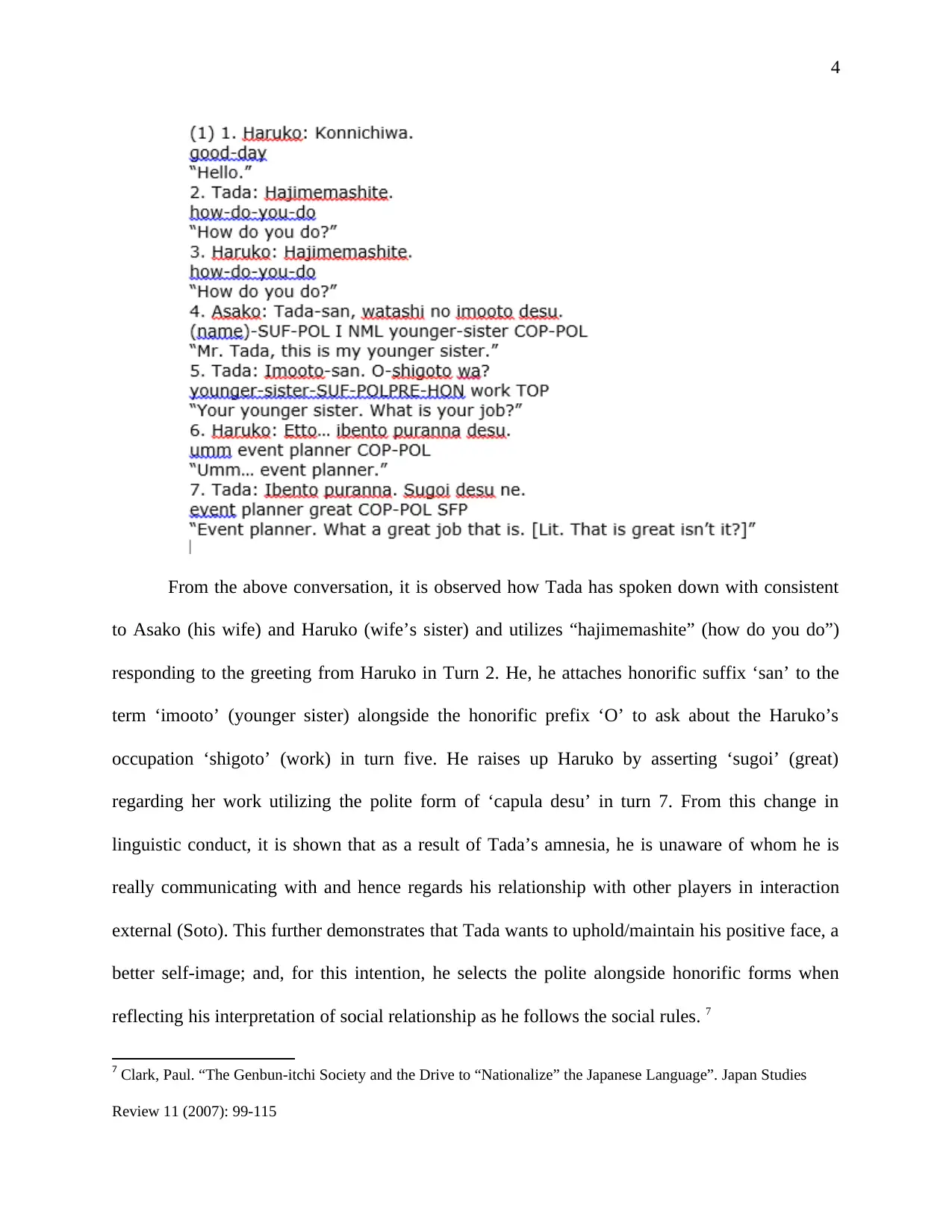
4
From the above conversation, it is observed how Tada has spoken down with consistent
to Asako (his wife) and Haruko (wife’s sister) and utilizes “hajimemashite” (how do you do”)
responding to the greeting from Haruko in Turn 2. He, he attaches honorific suffix ‘san’ to the
term ‘imooto’ (younger sister) alongside the honorific prefix ‘O’ to ask about the Haruko’s
occupation ‘shigoto’ (work) in turn five. He raises up Haruko by asserting ‘sugoi’ (great)
regarding her work utilizing the polite form of ‘capula desu’ in turn 7. From this change in
linguistic conduct, it is shown that as a result of Tada’s amnesia, he is unaware of whom he is
really communicating with and hence regards his relationship with other players in interaction
external (Soto). This further demonstrates that Tada wants to uphold/maintain his positive face, a
better self-image; and, for this intention, he selects the polite alongside honorific forms when
reflecting his interpretation of social relationship as he follows the social rules. 7
7 Clark, Paul. “The Genbun-itchi Society and the Drive to “Nationalize” the Japanese Language”. Japan Studies
Review 11 (2007): 99-115
From the above conversation, it is observed how Tada has spoken down with consistent
to Asako (his wife) and Haruko (wife’s sister) and utilizes “hajimemashite” (how do you do”)
responding to the greeting from Haruko in Turn 2. He, he attaches honorific suffix ‘san’ to the
term ‘imooto’ (younger sister) alongside the honorific prefix ‘O’ to ask about the Haruko’s
occupation ‘shigoto’ (work) in turn five. He raises up Haruko by asserting ‘sugoi’ (great)
regarding her work utilizing the polite form of ‘capula desu’ in turn 7. From this change in
linguistic conduct, it is shown that as a result of Tada’s amnesia, he is unaware of whom he is
really communicating with and hence regards his relationship with other players in interaction
external (Soto). This further demonstrates that Tada wants to uphold/maintain his positive face, a
better self-image; and, for this intention, he selects the polite alongside honorific forms when
reflecting his interpretation of social relationship as he follows the social rules. 7
7 Clark, Paul. “The Genbun-itchi Society and the Drive to “Nationalize” the Japanese Language”. Japan Studies
Review 11 (2007): 99-115
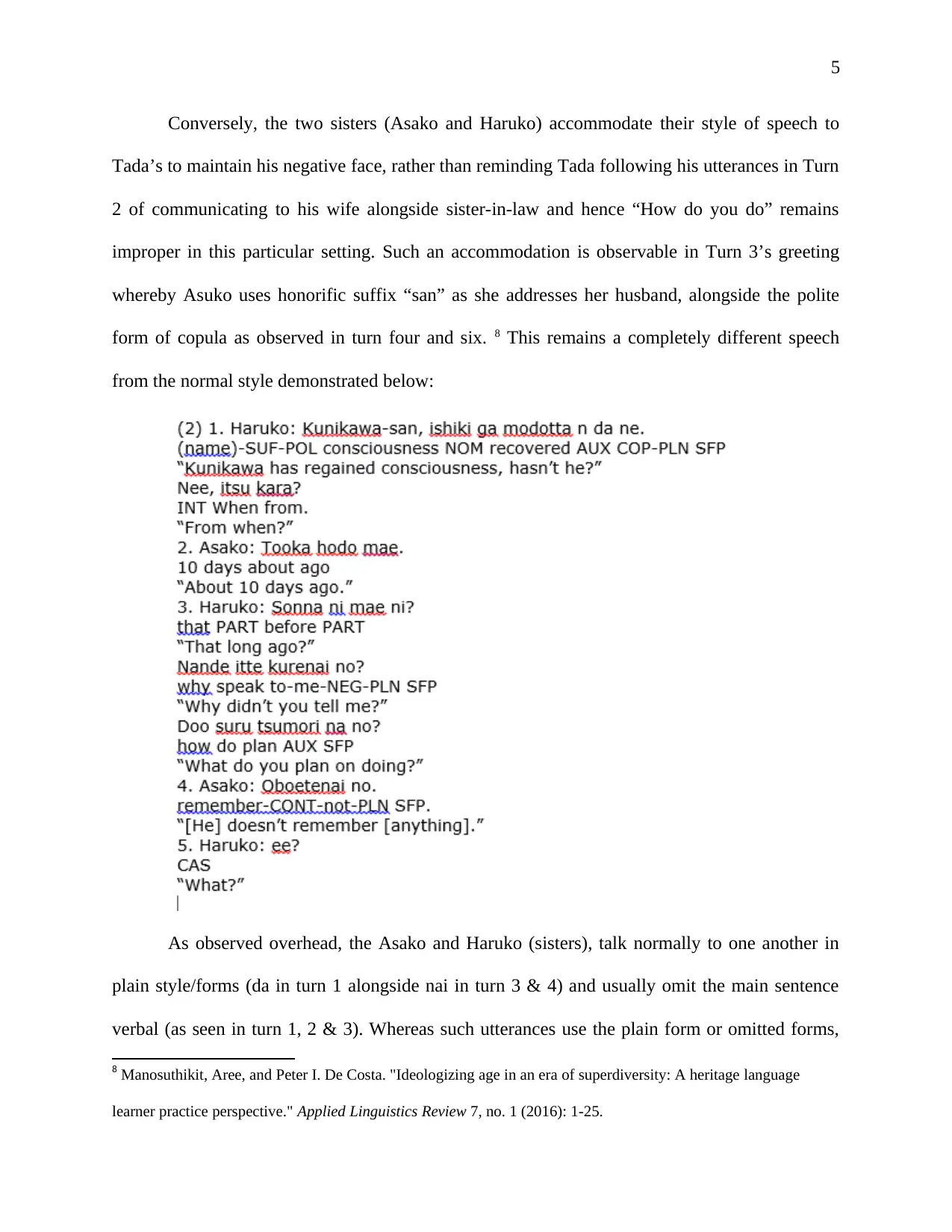
5
Conversely, the two sisters (Asako and Haruko) accommodate their style of speech to
Tada’s to maintain his negative face, rather than reminding Tada following his utterances in Turn
2 of communicating to his wife alongside sister-in-law and hence “How do you do” remains
improper in this particular setting. Such an accommodation is observable in Turn 3’s greeting
whereby Asuko uses honorific suffix “san” as she addresses her husband, alongside the polite
form of copula as observed in turn four and six. 8 This remains a completely different speech
from the normal style demonstrated below:
As observed overhead, the Asako and Haruko (sisters), talk normally to one another in
plain style/forms (da in turn 1 alongside nai in turn 3 & 4) and usually omit the main sentence
verbal (as seen in turn 1, 2 & 3). Whereas such utterances use the plain form or omitted forms,
8 Manosuthikit, Aree, and Peter I. De Costa. "Ideologizing age in an era of superdiversity: A heritage language
learner practice perspective." Applied Linguistics Review 7, no. 1 (2016): 1-25.
Conversely, the two sisters (Asako and Haruko) accommodate their style of speech to
Tada’s to maintain his negative face, rather than reminding Tada following his utterances in Turn
2 of communicating to his wife alongside sister-in-law and hence “How do you do” remains
improper in this particular setting. Such an accommodation is observable in Turn 3’s greeting
whereby Asuko uses honorific suffix “san” as she addresses her husband, alongside the polite
form of copula as observed in turn four and six. 8 This remains a completely different speech
from the normal style demonstrated below:
As observed overhead, the Asako and Haruko (sisters), talk normally to one another in
plain style/forms (da in turn 1 alongside nai in turn 3 & 4) and usually omit the main sentence
verbal (as seen in turn 1, 2 & 3). Whereas such utterances use the plain form or omitted forms,
8 Manosuthikit, Aree, and Peter I. De Costa. "Ideologizing age in an era of superdiversity: A heritage language
learner practice perspective." Applied Linguistics Review 7, no. 1 (2016): 1-25.
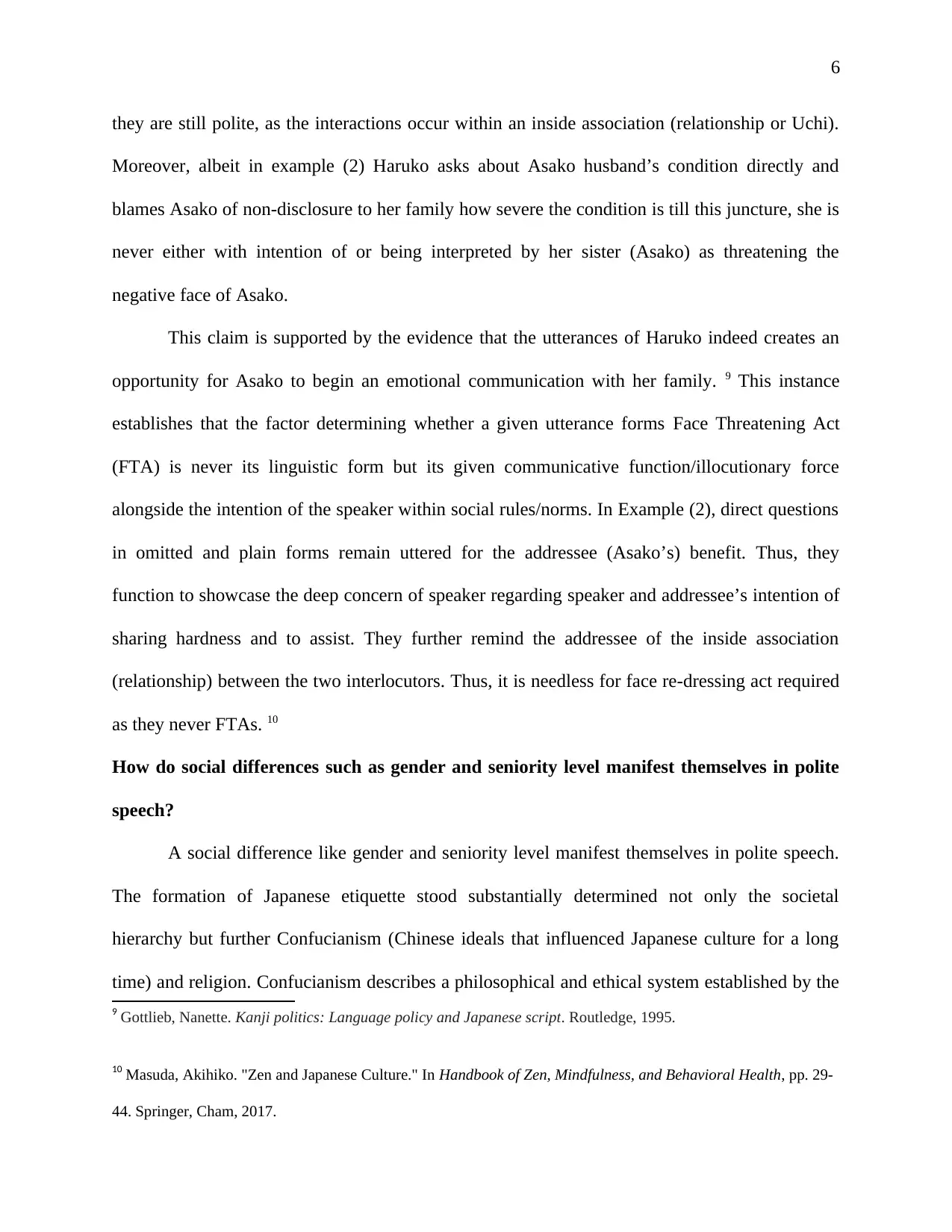
6
they are still polite, as the interactions occur within an inside association (relationship or Uchi).
Moreover, albeit in example (2) Haruko asks about Asako husband’s condition directly and
blames Asako of non-disclosure to her family how severe the condition is till this juncture, she is
never either with intention of or being interpreted by her sister (Asako) as threatening the
negative face of Asako.
This claim is supported by the evidence that the utterances of Haruko indeed creates an
opportunity for Asako to begin an emotional communication with her family. 9 This instance
establishes that the factor determining whether a given utterance forms Face Threatening Act
(FTA) is never its linguistic form but its given communicative function/illocutionary force
alongside the intention of the speaker within social rules/norms. In Example (2), direct questions
in omitted and plain forms remain uttered for the addressee (Asako’s) benefit. Thus, they
function to showcase the deep concern of speaker regarding speaker and addressee’s intention of
sharing hardness and to assist. They further remind the addressee of the inside association
(relationship) between the two interlocutors. Thus, it is needless for face re-dressing act required
as they never FTAs. 10
How do social differences such as gender and seniority level manifest themselves in polite
speech?
A social difference like gender and seniority level manifest themselves in polite speech.
The formation of Japanese etiquette stood substantially determined not only the societal
hierarchy but further Confucianism (Chinese ideals that influenced Japanese culture for a long
time) and religion. Confucianism describes a philosophical and ethical system established by the
9 Gottlieb, Nanette. Kanji politics: Language policy and Japanese script. Routledge, 1995.
10 Masuda, Akihiko. "Zen and Japanese Culture." In Handbook of Zen, Mindfulness, and Behavioral Health, pp. 29-
44. Springer, Cham, 2017.
they are still polite, as the interactions occur within an inside association (relationship or Uchi).
Moreover, albeit in example (2) Haruko asks about Asako husband’s condition directly and
blames Asako of non-disclosure to her family how severe the condition is till this juncture, she is
never either with intention of or being interpreted by her sister (Asako) as threatening the
negative face of Asako.
This claim is supported by the evidence that the utterances of Haruko indeed creates an
opportunity for Asako to begin an emotional communication with her family. 9 This instance
establishes that the factor determining whether a given utterance forms Face Threatening Act
(FTA) is never its linguistic form but its given communicative function/illocutionary force
alongside the intention of the speaker within social rules/norms. In Example (2), direct questions
in omitted and plain forms remain uttered for the addressee (Asako’s) benefit. Thus, they
function to showcase the deep concern of speaker regarding speaker and addressee’s intention of
sharing hardness and to assist. They further remind the addressee of the inside association
(relationship) between the two interlocutors. Thus, it is needless for face re-dressing act required
as they never FTAs. 10
How do social differences such as gender and seniority level manifest themselves in polite
speech?
A social difference like gender and seniority level manifest themselves in polite speech.
The formation of Japanese etiquette stood substantially determined not only the societal
hierarchy but further Confucianism (Chinese ideals that influenced Japanese culture for a long
time) and religion. Confucianism describes a philosophical and ethical system established by the
9 Gottlieb, Nanette. Kanji politics: Language policy and Japanese script. Routledge, 1995.
10 Masuda, Akihiko. "Zen and Japanese Culture." In Handbook of Zen, Mindfulness, and Behavioral Health, pp. 29-
44. Springer, Cham, 2017.
Paraphrase This Document
Need a fresh take? Get an instant paraphrase of this document with our AI Paraphraser
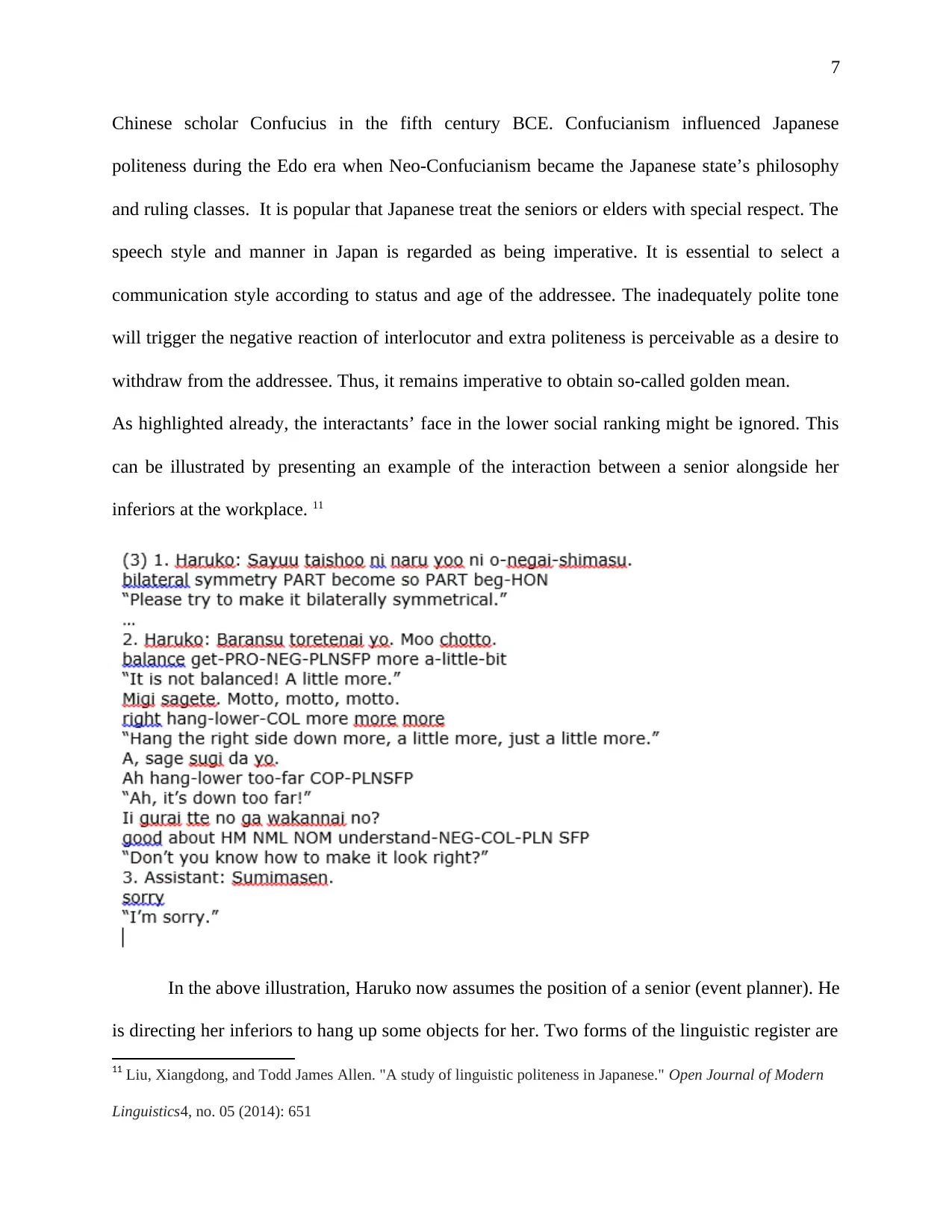
7
Chinese scholar Confucius in the fifth century BCE. Confucianism influenced Japanese
politeness during the Edo era when Neo-Confucianism became the Japanese state’s philosophy
and ruling classes. It is popular that Japanese treat the seniors or elders with special respect. The
speech style and manner in Japan is regarded as being imperative. It is essential to select a
communication style according to status and age of the addressee. The inadequately polite tone
will trigger the negative reaction of interlocutor and extra politeness is perceivable as a desire to
withdraw from the addressee. Thus, it remains imperative to obtain so-called golden mean.
As highlighted already, the interactants’ face in the lower social ranking might be ignored. This
can be illustrated by presenting an example of the interaction between a senior alongside her
inferiors at the workplace. 11
In the above illustration, Haruko now assumes the position of a senior (event planner). He
is directing her inferiors to hang up some objects for her. Two forms of the linguistic register are
11 Liu, Xiangdong, and Todd James Allen. "A study of linguistic politeness in Japanese." Open Journal of Modern
Linguistics4, no. 05 (2014): 651
Chinese scholar Confucius in the fifth century BCE. Confucianism influenced Japanese
politeness during the Edo era when Neo-Confucianism became the Japanese state’s philosophy
and ruling classes. It is popular that Japanese treat the seniors or elders with special respect. The
speech style and manner in Japan is regarded as being imperative. It is essential to select a
communication style according to status and age of the addressee. The inadequately polite tone
will trigger the negative reaction of interlocutor and extra politeness is perceivable as a desire to
withdraw from the addressee. Thus, it remains imperative to obtain so-called golden mean.
As highlighted already, the interactants’ face in the lower social ranking might be ignored. This
can be illustrated by presenting an example of the interaction between a senior alongside her
inferiors at the workplace. 11
In the above illustration, Haruko now assumes the position of a senior (event planner). He
is directing her inferiors to hang up some objects for her. Two forms of the linguistic register are
11 Liu, Xiangdong, and Todd James Allen. "A study of linguistic politeness in Japanese." Open Journal of Modern
Linguistics4, no. 05 (2014): 651
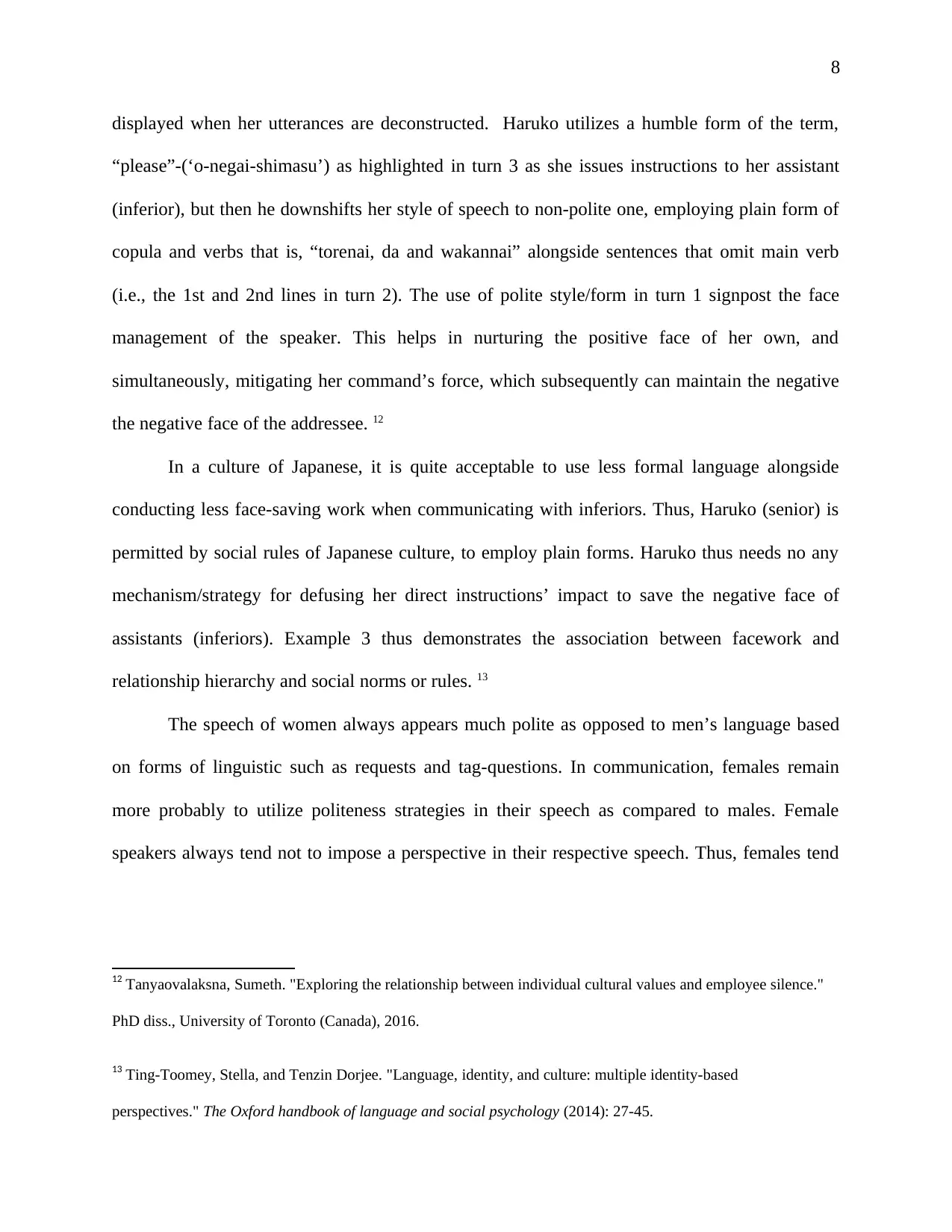
8
displayed when her utterances are deconstructed. Haruko utilizes a humble form of the term,
“please”-(‘o-negai-shimasu’) as highlighted in turn 3 as she issues instructions to her assistant
(inferior), but then he downshifts her style of speech to non-polite one, employing plain form of
copula and verbs that is, “torenai, da and wakannai” alongside sentences that omit main verb
(i.e., the 1st and 2nd lines in turn 2). The use of polite style/form in turn 1 signpost the face
management of the speaker. This helps in nurturing the positive face of her own, and
simultaneously, mitigating her command’s force, which subsequently can maintain the negative
the negative face of the addressee. 12
In a culture of Japanese, it is quite acceptable to use less formal language alongside
conducting less face-saving work when communicating with inferiors. Thus, Haruko (senior) is
permitted by social rules of Japanese culture, to employ plain forms. Haruko thus needs no any
mechanism/strategy for defusing her direct instructions’ impact to save the negative face of
assistants (inferiors). Example 3 thus demonstrates the association between facework and
relationship hierarchy and social norms or rules. 13
The speech of women always appears much polite as opposed to men’s language based
on forms of linguistic such as requests and tag-questions. In communication, females remain
more probably to utilize politeness strategies in their speech as compared to males. Female
speakers always tend not to impose a perspective in their respective speech. Thus, females tend
12 Tanyaovalaksna, Sumeth. "Exploring the relationship between individual cultural values and employee silence."
PhD diss., University of Toronto (Canada), 2016.
13 Ting-Toomey, Stella, and Tenzin Dorjee. "Language, identity, and culture: multiple identity-based
perspectives." The Oxford handbook of language and social psychology (2014): 27-45.
displayed when her utterances are deconstructed. Haruko utilizes a humble form of the term,
“please”-(‘o-negai-shimasu’) as highlighted in turn 3 as she issues instructions to her assistant
(inferior), but then he downshifts her style of speech to non-polite one, employing plain form of
copula and verbs that is, “torenai, da and wakannai” alongside sentences that omit main verb
(i.e., the 1st and 2nd lines in turn 2). The use of polite style/form in turn 1 signpost the face
management of the speaker. This helps in nurturing the positive face of her own, and
simultaneously, mitigating her command’s force, which subsequently can maintain the negative
the negative face of the addressee. 12
In a culture of Japanese, it is quite acceptable to use less formal language alongside
conducting less face-saving work when communicating with inferiors. Thus, Haruko (senior) is
permitted by social rules of Japanese culture, to employ plain forms. Haruko thus needs no any
mechanism/strategy for defusing her direct instructions’ impact to save the negative face of
assistants (inferiors). Example 3 thus demonstrates the association between facework and
relationship hierarchy and social norms or rules. 13
The speech of women always appears much polite as opposed to men’s language based
on forms of linguistic such as requests and tag-questions. In communication, females remain
more probably to utilize politeness strategies in their speech as compared to males. Female
speakers always tend not to impose a perspective in their respective speech. Thus, females tend
12 Tanyaovalaksna, Sumeth. "Exploring the relationship between individual cultural values and employee silence."
PhD diss., University of Toronto (Canada), 2016.
13 Ting-Toomey, Stella, and Tenzin Dorjee. "Language, identity, and culture: multiple identity-based
perspectives." The Oxford handbook of language and social psychology (2014): 27-45.
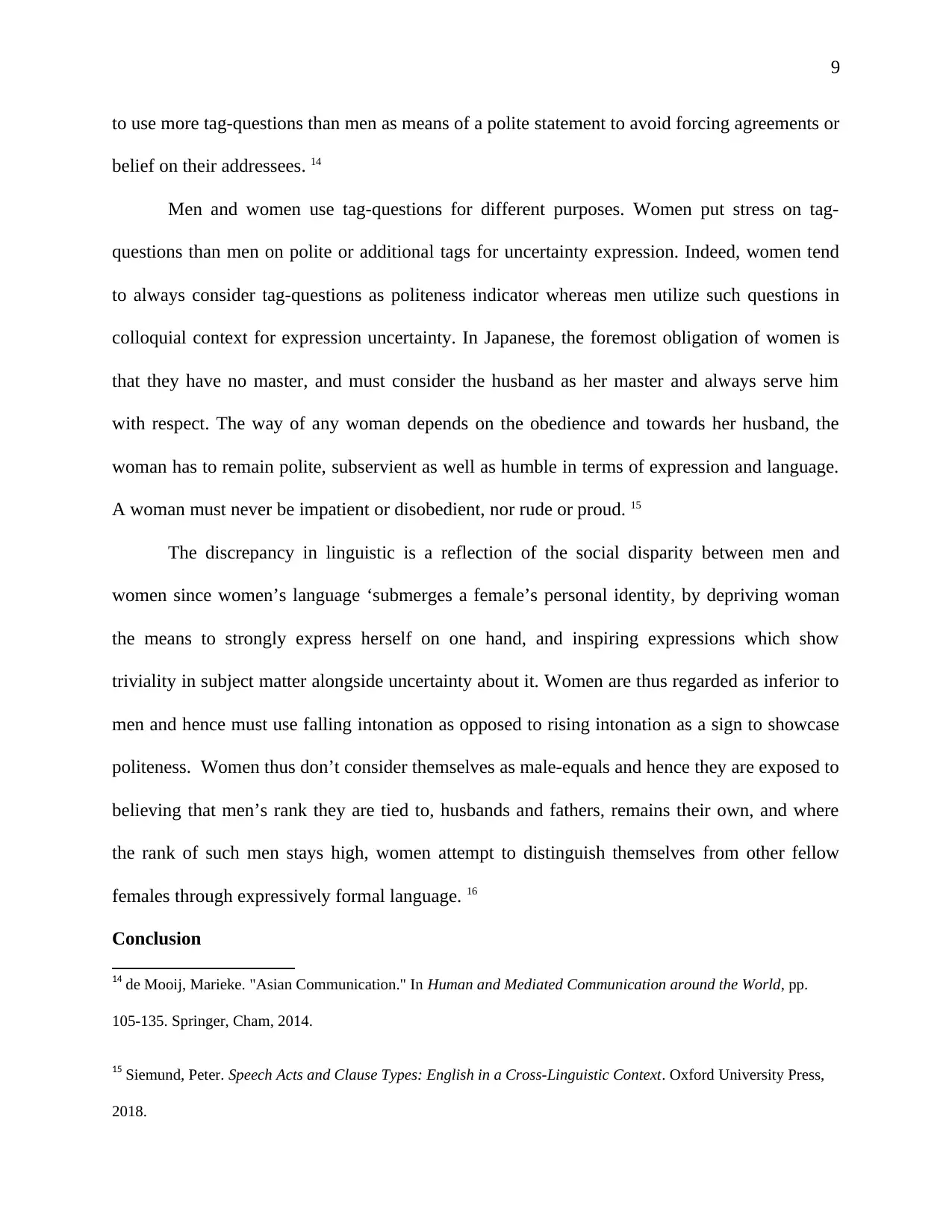
9
to use more tag-questions than men as means of a polite statement to avoid forcing agreements or
belief on their addressees. 14
Men and women use tag-questions for different purposes. Women put stress on tag-
questions than men on polite or additional tags for uncertainty expression. Indeed, women tend
to always consider tag-questions as politeness indicator whereas men utilize such questions in
colloquial context for expression uncertainty. In Japanese, the foremost obligation of women is
that they have no master, and must consider the husband as her master and always serve him
with respect. The way of any woman depends on the obedience and towards her husband, the
woman has to remain polite, subservient as well as humble in terms of expression and language.
A woman must never be impatient or disobedient, nor rude or proud. 15
The discrepancy in linguistic is a reflection of the social disparity between men and
women since women’s language ‘submerges a female’s personal identity, by depriving woman
the means to strongly express herself on one hand, and inspiring expressions which show
triviality in subject matter alongside uncertainty about it. Women are thus regarded as inferior to
men and hence must use falling intonation as opposed to rising intonation as a sign to showcase
politeness. Women thus don’t consider themselves as male-equals and hence they are exposed to
believing that men’s rank they are tied to, husbands and fathers, remains their own, and where
the rank of such men stays high, women attempt to distinguish themselves from other fellow
females through expressively formal language. 16
Conclusion
14 de Mooij, Marieke. "Asian Communication." In Human and Mediated Communication around the World, pp.
105-135. Springer, Cham, 2014.
15 Siemund, Peter. Speech Acts and Clause Types: English in a Cross-Linguistic Context. Oxford University Press,
2018.
to use more tag-questions than men as means of a polite statement to avoid forcing agreements or
belief on their addressees. 14
Men and women use tag-questions for different purposes. Women put stress on tag-
questions than men on polite or additional tags for uncertainty expression. Indeed, women tend
to always consider tag-questions as politeness indicator whereas men utilize such questions in
colloquial context for expression uncertainty. In Japanese, the foremost obligation of women is
that they have no master, and must consider the husband as her master and always serve him
with respect. The way of any woman depends on the obedience and towards her husband, the
woman has to remain polite, subservient as well as humble in terms of expression and language.
A woman must never be impatient or disobedient, nor rude or proud. 15
The discrepancy in linguistic is a reflection of the social disparity between men and
women since women’s language ‘submerges a female’s personal identity, by depriving woman
the means to strongly express herself on one hand, and inspiring expressions which show
triviality in subject matter alongside uncertainty about it. Women are thus regarded as inferior to
men and hence must use falling intonation as opposed to rising intonation as a sign to showcase
politeness. Women thus don’t consider themselves as male-equals and hence they are exposed to
believing that men’s rank they are tied to, husbands and fathers, remains their own, and where
the rank of such men stays high, women attempt to distinguish themselves from other fellow
females through expressively formal language. 16
Conclusion
14 de Mooij, Marieke. "Asian Communication." In Human and Mediated Communication around the World, pp.
105-135. Springer, Cham, 2014.
15 Siemund, Peter. Speech Acts and Clause Types: English in a Cross-Linguistic Context. Oxford University Press,
2018.
Secure Best Marks with AI Grader
Need help grading? Try our AI Grader for instant feedback on your assignments.
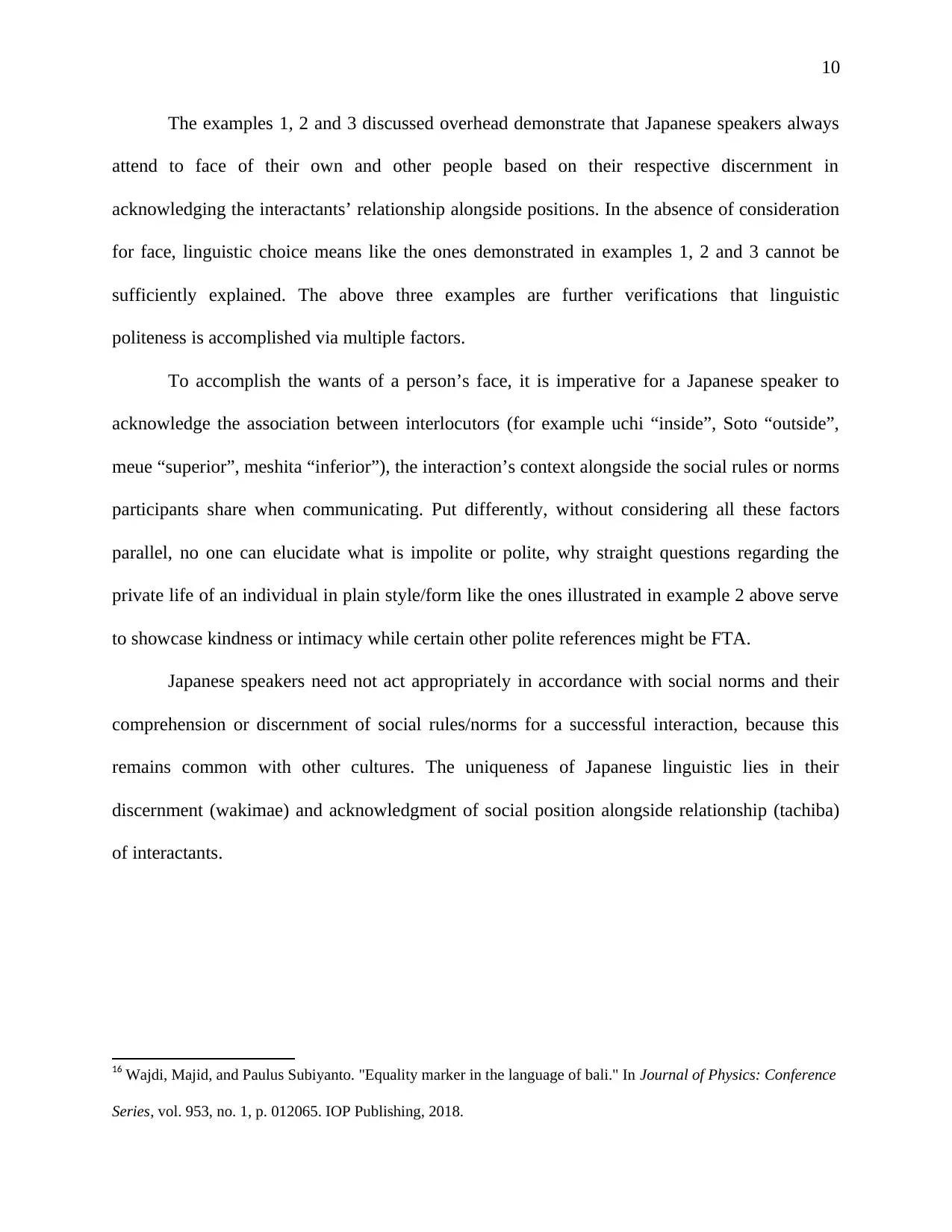
10
The examples 1, 2 and 3 discussed overhead demonstrate that Japanese speakers always
attend to face of their own and other people based on their respective discernment in
acknowledging the interactants’ relationship alongside positions. In the absence of consideration
for face, linguistic choice means like the ones demonstrated in examples 1, 2 and 3 cannot be
sufficiently explained. The above three examples are further verifications that linguistic
politeness is accomplished via multiple factors.
To accomplish the wants of a person’s face, it is imperative for a Japanese speaker to
acknowledge the association between interlocutors (for example uchi “inside”, Soto “outside”,
meue “superior”, meshita “inferior”), the interaction’s context alongside the social rules or norms
participants share when communicating. Put differently, without considering all these factors
parallel, no one can elucidate what is impolite or polite, why straight questions regarding the
private life of an individual in plain style/form like the ones illustrated in example 2 above serve
to showcase kindness or intimacy while certain other polite references might be FTA.
Japanese speakers need not act appropriately in accordance with social norms and their
comprehension or discernment of social rules/norms for a successful interaction, because this
remains common with other cultures. The uniqueness of Japanese linguistic lies in their
discernment (wakimae) and acknowledgment of social position alongside relationship (tachiba)
of interactants.
16 Wajdi, Majid, and Paulus Subiyanto. "Equality marker in the language of bali." In Journal of Physics: Conference
Series, vol. 953, no. 1, p. 012065. IOP Publishing, 2018.
The examples 1, 2 and 3 discussed overhead demonstrate that Japanese speakers always
attend to face of their own and other people based on their respective discernment in
acknowledging the interactants’ relationship alongside positions. In the absence of consideration
for face, linguistic choice means like the ones demonstrated in examples 1, 2 and 3 cannot be
sufficiently explained. The above three examples are further verifications that linguistic
politeness is accomplished via multiple factors.
To accomplish the wants of a person’s face, it is imperative for a Japanese speaker to
acknowledge the association between interlocutors (for example uchi “inside”, Soto “outside”,
meue “superior”, meshita “inferior”), the interaction’s context alongside the social rules or norms
participants share when communicating. Put differently, without considering all these factors
parallel, no one can elucidate what is impolite or polite, why straight questions regarding the
private life of an individual in plain style/form like the ones illustrated in example 2 above serve
to showcase kindness or intimacy while certain other polite references might be FTA.
Japanese speakers need not act appropriately in accordance with social norms and their
comprehension or discernment of social rules/norms for a successful interaction, because this
remains common with other cultures. The uniqueness of Japanese linguistic lies in their
discernment (wakimae) and acknowledgment of social position alongside relationship (tachiba)
of interactants.
16 Wajdi, Majid, and Paulus Subiyanto. "Equality marker in the language of bali." In Journal of Physics: Conference
Series, vol. 953, no. 1, p. 012065. IOP Publishing, 2018.
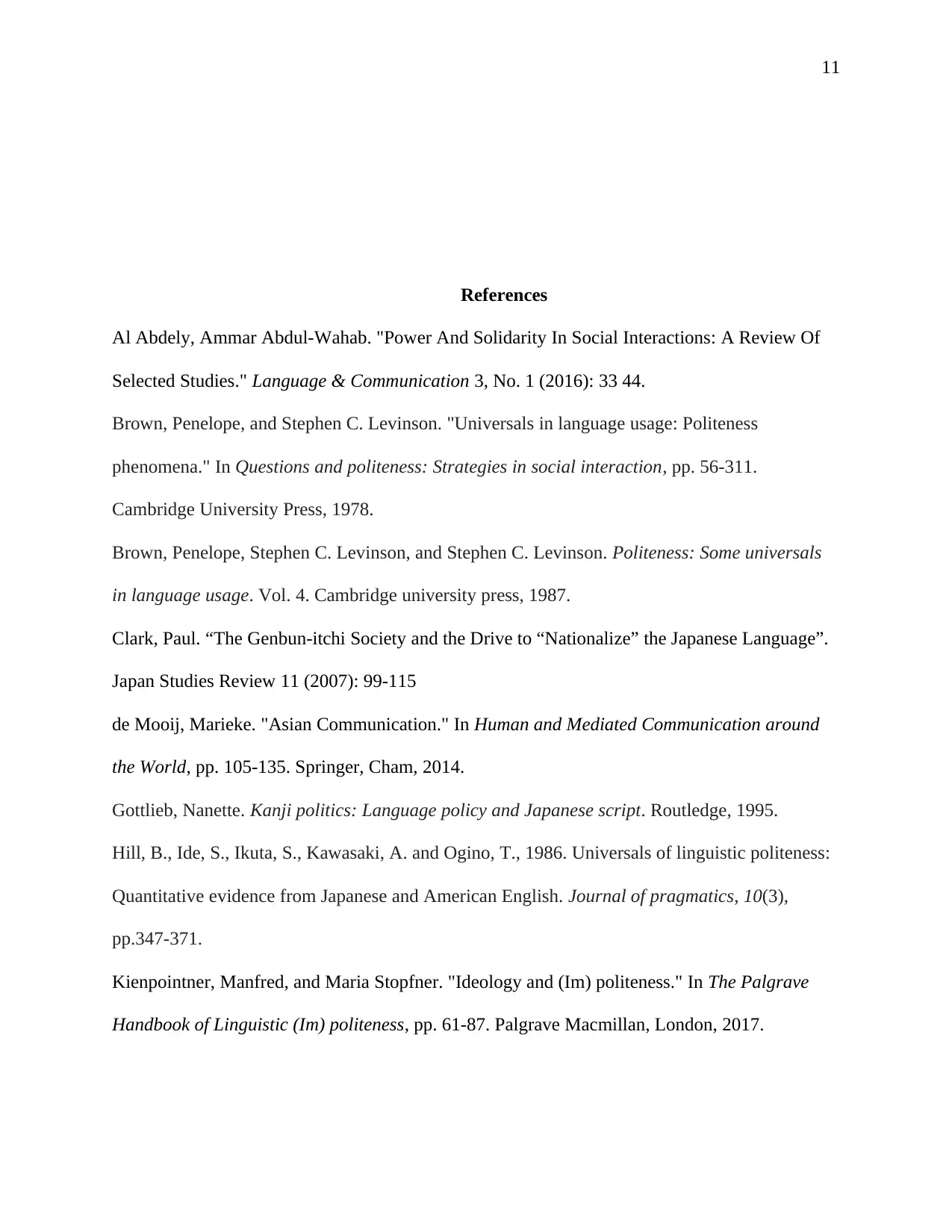
11
References
Al Abdely, Ammar Abdul-Wahab. "Power And Solidarity In Social Interactions: A Review Of
Selected Studies." Language & Communication 3, No. 1 (2016): 33 44.
Brown, Penelope, and Stephen C. Levinson. "Universals in language usage: Politeness
phenomena." In Questions and politeness: Strategies in social interaction, pp. 56-311.
Cambridge University Press, 1978.
Brown, Penelope, Stephen C. Levinson, and Stephen C. Levinson. Politeness: Some universals
in language usage. Vol. 4. Cambridge university press, 1987.
Clark, Paul. “The Genbun-itchi Society and the Drive to “Nationalize” the Japanese Language”.
Japan Studies Review 11 (2007): 99-115
de Mooij, Marieke. "Asian Communication." In Human and Mediated Communication around
the World, pp. 105-135. Springer, Cham, 2014.
Gottlieb, Nanette. Kanji politics: Language policy and Japanese script. Routledge, 1995.
Hill, B., Ide, S., Ikuta, S., Kawasaki, A. and Ogino, T., 1986. Universals of linguistic politeness:
Quantitative evidence from Japanese and American English. Journal of pragmatics, 10(3),
pp.347-371.
Kienpointner, Manfred, and Maria Stopfner. "Ideology and (Im) politeness." In The Palgrave
Handbook of Linguistic (Im) politeness, pp. 61-87. Palgrave Macmillan, London, 2017.
References
Al Abdely, Ammar Abdul-Wahab. "Power And Solidarity In Social Interactions: A Review Of
Selected Studies." Language & Communication 3, No. 1 (2016): 33 44.
Brown, Penelope, and Stephen C. Levinson. "Universals in language usage: Politeness
phenomena." In Questions and politeness: Strategies in social interaction, pp. 56-311.
Cambridge University Press, 1978.
Brown, Penelope, Stephen C. Levinson, and Stephen C. Levinson. Politeness: Some universals
in language usage. Vol. 4. Cambridge university press, 1987.
Clark, Paul. “The Genbun-itchi Society and the Drive to “Nationalize” the Japanese Language”.
Japan Studies Review 11 (2007): 99-115
de Mooij, Marieke. "Asian Communication." In Human and Mediated Communication around
the World, pp. 105-135. Springer, Cham, 2014.
Gottlieb, Nanette. Kanji politics: Language policy and Japanese script. Routledge, 1995.
Hill, B., Ide, S., Ikuta, S., Kawasaki, A. and Ogino, T., 1986. Universals of linguistic politeness:
Quantitative evidence from Japanese and American English. Journal of pragmatics, 10(3),
pp.347-371.
Kienpointner, Manfred, and Maria Stopfner. "Ideology and (Im) politeness." In The Palgrave
Handbook of Linguistic (Im) politeness, pp. 61-87. Palgrave Macmillan, London, 2017.
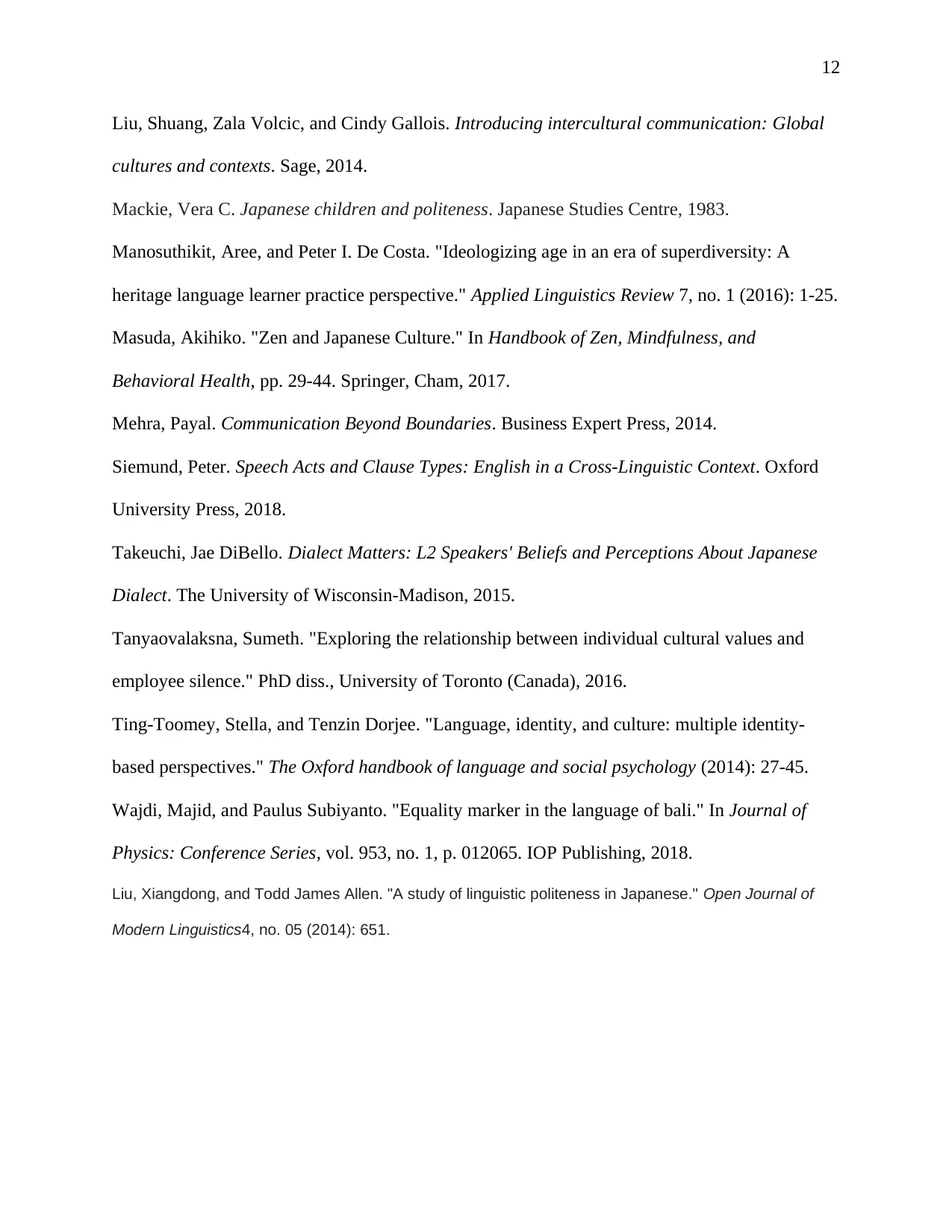
12
Liu, Shuang, Zala Volcic, and Cindy Gallois. Introducing intercultural communication: Global
cultures and contexts. Sage, 2014.
Mackie, Vera C. Japanese children and politeness. Japanese Studies Centre, 1983.
Manosuthikit, Aree, and Peter I. De Costa. "Ideologizing age in an era of superdiversity: A
heritage language learner practice perspective." Applied Linguistics Review 7, no. 1 (2016): 1-25.
Masuda, Akihiko. "Zen and Japanese Culture." In Handbook of Zen, Mindfulness, and
Behavioral Health, pp. 29-44. Springer, Cham, 2017.
Mehra, Payal. Communication Beyond Boundaries. Business Expert Press, 2014.
Siemund, Peter. Speech Acts and Clause Types: English in a Cross-Linguistic Context. Oxford
University Press, 2018.
Takeuchi, Jae DiBello. Dialect Matters: L2 Speakers' Beliefs and Perceptions About Japanese
Dialect. The University of Wisconsin-Madison, 2015.
Tanyaovalaksna, Sumeth. "Exploring the relationship between individual cultural values and
employee silence." PhD diss., University of Toronto (Canada), 2016.
Ting-Toomey, Stella, and Tenzin Dorjee. "Language, identity, and culture: multiple identity-
based perspectives." The Oxford handbook of language and social psychology (2014): 27-45.
Wajdi, Majid, and Paulus Subiyanto. "Equality marker in the language of bali." In Journal of
Physics: Conference Series, vol. 953, no. 1, p. 012065. IOP Publishing, 2018.
Liu, Xiangdong, and Todd James Allen. "A study of linguistic politeness in Japanese." Open Journal of
Modern Linguistics4, no. 05 (2014): 651.
Liu, Shuang, Zala Volcic, and Cindy Gallois. Introducing intercultural communication: Global
cultures and contexts. Sage, 2014.
Mackie, Vera C. Japanese children and politeness. Japanese Studies Centre, 1983.
Manosuthikit, Aree, and Peter I. De Costa. "Ideologizing age in an era of superdiversity: A
heritage language learner practice perspective." Applied Linguistics Review 7, no. 1 (2016): 1-25.
Masuda, Akihiko. "Zen and Japanese Culture." In Handbook of Zen, Mindfulness, and
Behavioral Health, pp. 29-44. Springer, Cham, 2017.
Mehra, Payal. Communication Beyond Boundaries. Business Expert Press, 2014.
Siemund, Peter. Speech Acts and Clause Types: English in a Cross-Linguistic Context. Oxford
University Press, 2018.
Takeuchi, Jae DiBello. Dialect Matters: L2 Speakers' Beliefs and Perceptions About Japanese
Dialect. The University of Wisconsin-Madison, 2015.
Tanyaovalaksna, Sumeth. "Exploring the relationship between individual cultural values and
employee silence." PhD diss., University of Toronto (Canada), 2016.
Ting-Toomey, Stella, and Tenzin Dorjee. "Language, identity, and culture: multiple identity-
based perspectives." The Oxford handbook of language and social psychology (2014): 27-45.
Wajdi, Majid, and Paulus Subiyanto. "Equality marker in the language of bali." In Journal of
Physics: Conference Series, vol. 953, no. 1, p. 012065. IOP Publishing, 2018.
Liu, Xiangdong, and Todd James Allen. "A study of linguistic politeness in Japanese." Open Journal of
Modern Linguistics4, no. 05 (2014): 651.
1 out of 13
Your All-in-One AI-Powered Toolkit for Academic Success.
+13062052269
info@desklib.com
Available 24*7 on WhatsApp / Email
![[object Object]](/_next/static/media/star-bottom.7253800d.svg)
Unlock your academic potential
© 2024 | Zucol Services PVT LTD | All rights reserved.